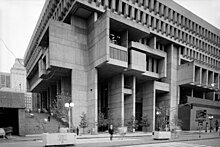Béton brut
Appearance

Béton brut (French pronunciation: [betɔ̃ bʁy], raw concrete) is architectural concrete left unfinished or roughly-finished after pouring and left exposed visually. The imprint of the wood or plywood forms used for pouring is usually present on the final surface.
The use of béton brut was pioneered by Auguste Perret and other modern architects. It was used in such buildings as Unité d'Habitation in the early part of the twentieth century. It flourished as a part of the brutalist architecture of the 1960s and 70s. This largely gave way to structural expressionism as steel structures became more advanced and practical. Wood-imprinted concrete is still popular in landscaping.
Examples
- The Evergreen State College
- Boston City Hall
- Royal National Theatre, London
- Unité d'Habitation
- Habitat 67
- The main branch of the Orange County Library System in Florida
See also
External links
